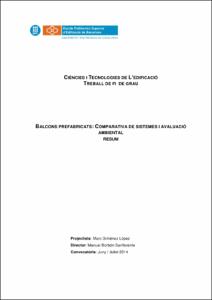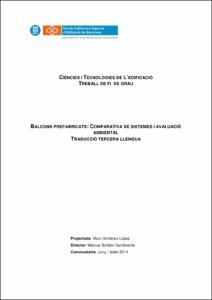Mostra el registre d'ítem simple
Balcons prefabricats: Comparativa de sistemes i avaluació ambiental
| dc.contributor | Borbón Sanllorente, Manuel |
| dc.contributor.author | Giménez López, Marc |
| dc.contributor.other | Universitat Politècnica de Catalunya. Departament de Construccions Arquitectòniques II |
| dc.date.accessioned | 2015-01-23T10:12:08Z |
| dc.date.available | 2015-01-23T10:12:08Z |
| dc.date.issued | 2014-07 |
| dc.identifier.uri | http://hdl.handle.net/2099.1/24683 |
| dc.description.abstract | The aim of this project is to carry out a comparison under environmental parameters between an on-site procedure of a balcony in a state of rehabilitation against the introduction of a precast element. Thus, it is expected to see the advantages and disadvantages which both solutions present and to decide the most adequate of the two, finding a balance not only between the economic cost, a factor promoters have to take into account, but also all the energy involved in the whole intervention. This project stems from the curiosity generated in the final stage of the degree, in connection with the energy consumption of the different activities that take place in our industry and the ability of a precast element to lessen it. Could it be a new area for our sector? Is this alternative effectively feasible? This project began in order to solve these two questions, firstly giving an overview of the current situation of prefabrication of balconies in the European territory. Secondly, injuries to which this element is exposed are introduced and how due to them balconies need to be rehabilitated or replaced. In order to better understand this element, it is shown how the rehabilitation process of a balcony is carried out and how such anomalies are solved. Once the factors concerning the balcony rehabilitating have been introduced, the project is focused on trying to resolve the questions generated and raised above, by means of an energetic comparison between the on-site rehabilitation techniques currently used against the introduction precast element. To carry out this comparison, on the one hand, four proposals of prefabricated systems have presented are presented to solve four real cases of balconies in a state of rehabilitation. On the other hand, the energy consumption and CO emissions that each activity entails as well as the cost of whole intervention have been analyzed by the database BEDEC provided by ITEC, which reveals these factors in relation to the construction unit. It must be noted that this tool, although very detailed in number of units, it is not accurate enough to comprehensively evaluate this element, so it has not been possible to extract an exact evaluation of each example. For this reason, the results can only be presented as consumption estimations and has helped to see what processes consume more, but not to give a specific and reliable value of the set. |
| dc.language.iso | eng |
| dc.language.iso | cat |
| dc.publisher | Universitat Politècnica de Catalunya |
| dc.rights | Attribution-NonCommercial-NoDerivs 3.0 Spain |
| dc.rights.uri | http://creativecommons.org/licenses/by-nc-nd/3.0/es/ |
| dc.subject | Àrees temàtiques de la UPC::Edificació::Tècniques i sistemes constructius ::Sistemes constructius industrialitzats |
| dc.subject.lcsh | Industrialized building |
| dc.title | Balcons prefabricats: Comparativa de sistemes i avaluació ambiental |
| dc.type | Bachelor thesis |
| dc.subject.lemac | Industrialització de la construcció |
| dc.subject.lemac | Balcons |
| dc.rights.access | Open Access |
| dc.audience.educationlevel | Grau |
| dc.audience.mediator | Escola Politècnica Superior d'Edificació de Barcelona |
| dc.audience.degree | GRAU EN CIÈNCIES I TECNOLOGIES DE L'EDIFICACIÓ (Pla 2009) |




